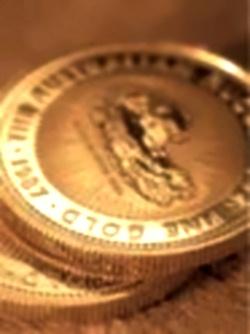A Gentle Bull?
Ever so gradually, the EU has been replacing the infrastructure and symbols of its member countries. National laws and institutions are giving way to supranational entities controlled from Brussels. As this process continues, one striking image is appearing more and more frequently on European Union official documents—a bull moving forward amidst five stars—an image hearkening back to an ancient Greek myth. But what exactly does it mean?
After rejecting the Lisbon Treaty in a June 2008 plebiscite, Irish voters on October 2 this year ratified the controversial measure, which effectively binds their nation into a tighter political and economic union with the Eurozone. But while many are pondering the election results, the fact of the matter is that throughout the European Union, voters have surprisingly little say, as an unelected European Commission initiates most legislation. The elected European Parliament may be able to debate proposed legislation, but it does not truly have the final say. Did Irish public opinion actually change so dramatically between the June 2008 "No" vote and the October 2009 "Yes"? Or was this merely another case of EU "power politics" forcing its will on a nation that ultimately had no real choice in the matter?
From Small Beginnings
The impetus to create a European Union sprang from the devastating results of two World Wars fought largely on the fields of Europe, as nations still reeling from World War II sought to stabilize their nations' economies and prevent future wars among European neighbors.
What started as the European Coal and Steel Community in 1951 expanded to a European Economic Community in 1958, then after 1993 saw the birth of the European Union as we know it today. "Eurosceptics" suggest that the EU, with its several bureaucratic structures atop and beside one another, has employed a deliberate lack of transparency to hide its actual eventual goal—formation of a true federal union of Europe—from Europe's politicians. Eurosceptics charge that the EU's master strategists used duplicity to trick nations and their leaders into joining an economic union that they had falsely promised would not develop into a political and military entity.
Maybe Europe's national leaders should have read what German politician Franz Josef Strauss (1915–88), the Bavarian leader of his nation's Christian Social Union, wrote in his landmark 1966 book, The Grand Design: "We must now consider the problem of how this Europe is to be achieved… There are two possible conceptions here. The first is that of a European commonwealth, a welfare community of nations with growing economic, trade and living standards, but without a central political goal or the determination to achieve it. The more desirable alternative is a Europe growing in stages, determined to assert its role in the world, exercising increasing influence and attraction… growing in confidence and world importance" (pp. 21–22, emphasis mine).
Strauss continued, "The balance of power can only be re-established on the European continent if the classic nineteenth-century pentarchy of Britain, France, Germany, Austria-Hungary and Russia is succeeded by a confederation which will in due course develop into a federation" (p. 23).
Franz Josef Strauss's second option has clearly become the preferred choice for the new Europe.
Zeitgeist
What Europe is now experiencing is a renaissance. It is not just a rebirth of art and culture but of identity. The Germans have a word—zeitgeist—to describe the recrudescence of an old time. Zeitgeist has no adequate English translation, but the concept is somewhat like "the spirit of the time." German philosophers and writers of the late nineteenth century took the word, coined by Johann Herder in 1769, and developed it to mean a "guiding spirit" for Germany and its destiny in Europe. It evoked the times of the Teutonic knights and the domination of Europe by the Holy Roman Empire. We could very well be at a time when old spirits will rise again and kindle Europe's dream of influencing a far wider world than just its own continent.
Ever so gradually, the EU has been replacing the infrastructure and symbols of its member countries. National laws and institutions are giving way to supranational entities controlled from Brussels. As this process continues, one striking image is appearing more and more frequently on European Union official documents—a bull moving forward amidst five stars—an image hearkening back to an ancient Greek myth. But what exactly does it mean?
A Woman Sits Astride a Bull
The bull we find on EU documents hearkens back to the ancient Greek myth of Europa, in which the god Zeus, manifested as a bull, seduces the lovely young Phoenician princess Europa. "Uncommonly gentle, the bull inspired no fear. Decking its horns with flowers, Europa climbed upon its back, whereupon the bull—Zeus—took off at a trot and dived into the sea" (European Union Law, Chalmers et al., Cambridge University Press, p. vii).
Your Bible often uses a "woman" as the symbol of a church. In today's EU documents we do not yet see a woman seated upon the bull's back. But the symbolism is apt. A powerful yet innocent-seeming force is beginning to shape the destiny of Europe. Bible students recognize that in the not-too-distant future, when we see a concordat between Europe's political and religious institutions, a key prophecy revealed by Jesus Christ to the Apostle John will have come to pass. What does the Bible say will become of the bull and its rider?
Many biblical scholars have drawn a parallel between the Europa myth and the book of Revelation's account of a future Babylonian system that will control Europe in the end days. In this scenario, a great religious system symbolized by the Babylonian woman sits astride a powerful political and military beast.
"…And I saw a woman sitting on a scarlet beast which was full of names of blasphemy, having seven heads and ten horns. The woman was arrayed in purple and scarlet [colors often associated with religious attire], and adorned with gold and precious stones and pearls…" (Revelation 17:3–4).
The prophet Daniel was also given visions of this beast. It was to be the fourth of four beasts spanning the time from ancient Babylon till the days just ahead. We read, "The fourth beast shall be a fourth kingdom on earth, which shall be different from all other kingdoms, and shall devour the whole earth, trample it and break it in pieces" (Daniel 7:23).
The next verse introduces us to another king who will "speak pompous words against the Most High, shall persecute the saints of the Most High, and shall intend to change times and law. Then the saints shall be given into his hand, for a time and times and half a time" (vv. 24–25).
For nearly three and a half years, this prophesied political and religious union will dominate the world through trade and regulation. Already we are seeing how the European Union is setting standards for trade around the world. International traders have little choice but to comply with EU standards and measurements. Soon it will not be possible to export products unless they meet strict EU standards. Watch then for rules in the area of employment. Finally, universal monetary regulation could follow, building on the established monetary union brought by the euro.
The garlanded bull of the Europa myth may sound like a great story, but we should realize that in the biblical account it does not end "happily ever after." The "gentle bull" becomes a raging monster! This beast with ten horns (kings or rulers in biblical symbolism) will turn against the woman. "And the ten horns which you saw on the beast, these will hate the harlot, make her desolate and naked, eat her flesh and burn her with fire" (Revelation 17:16). A day will come when the millions who had sought a strong Europe, reunited under the banner of its shared religious and political heritage, will realize they have been deceived!
Would you like to know more about this coming political-religious system that will change the world? Please request your free copy of The Beast of Revelation, which will explain the biblical references behind these clear prophecies. You will be glad that you did.






